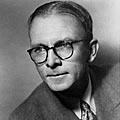Alan Paton (Pay-ton) 1903-1988

A rarity in his time, Paton was a white man in a country of oppressed blacks who fought for their freedom and believed in their worth. It has been said that Paton was "the man who pulled up the barbed wire fence and planted geraniums" in South Africa. As a chronicler of his times, he brought America and the rest of the world face-to-face and heart-to-heart with the problem of race relations in South Africa.
A Boy in the Beloved CountryAlan Paton loved the simple beauty of Pietermaritzburg, the rural town in the region of Natal, where he was born. Later in life, he would often find himself homesick for the exotic, tribal countryside of his youth. His father loved literature and was himself a writer, enjoying a local reputation as a poet. Alan was clever and astute and became an excellent student, entering high school a full two years early.
A Curious Mind and a Poet's Eye
Though trained as a physicist, Paton was a casual writer and poet as well as scientist throughout his life. During college, he was sent to England to represent Natal University at the first Imperial Conference of Studies, where he wrote a highly praised paper analyzing the relationship between English and Dutch (Afrikaaner) South Africans. This was the first of many essays about South African politics written by Paton throughout his life.
Paton's Journey Towards Understanding
In his 20s, Paton undertook an important journey of the mind that changed his thinking and perceptions of South Africa. With the help of friends and mentors, he came to realize the true circumstances of most black South Africans, and to have compassion for them. As a man, he was dedicated to liberty. Over time, his thinking moved away from the environment of his upbringing and towards a better understanding of what liberty really means. He considered himself to have gone through five stages of personal change that helped him to empathize—with black and colored South Africans, and everyone less privileged than himself.
Out of this quest for liberty, Paton was appointed principal of the only reformatory for delinquent black African boys in the country. He was 32 when he moved to Johannesburg to take up his post. Many of these boys had come from tribal cultures and were struggling to assimilate to city life and the loss of the culture and comforts they had known. Paton was determined, through whatever means necessary, to educate them, change their circumstances and reform the system that oppressed them. Modeled after the elite education system in England, Paton turned what was a prison into a school focused on educating and advancing the boys in his charge.
Homesick and Searching
Homesick for his wife on a tour to study prisons in Europe, Canada and the United States, Paton needed something to fill his time. He was away from home for several months, he was lonely, his heart sang a song of South Africa—her beauty and her struggle. What's amazing about Paton's story is that he didn't expect to write a novel in the first place—the muse just took him. Inspired by John Steinbeck in The Grapes of Wrath, Paton began to write about real life in his homeland. Driven by his own moral struggles, Paton's book confronts the difficult choices every man faces in the course of his life. The experience of writing and publishing it changed Paton's life forever; the book changed the politics of a nation.
Discover little-known facts about Alan Paton.



